My experiment with baking an Einkorn Sandwich Loaf in a hot kitchen produced a fluffy loaf.
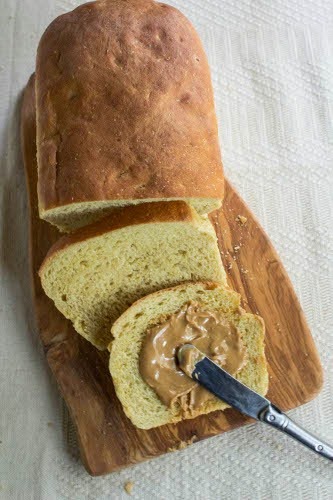
I’ve been working with einkorn flour for a couple of years, and as with every other type of grain I’ve experimented with, I’ve had some successes and some flops. It takes a little while to get used to how the grain works, especially when compared to regular bread flour, but that’s part of the fun.
The “Baking with Einkorn” workshop I attended a couple of weeks ago helped me understand more about the nuances of this flour. So after I got home, I couldn’t wait to begin testing this grain again.
Armed with some new tips and techniques, I set out to bake bread. I wanted to jump right in and start converting some of my favorite recipes now that I have a better idea of how to do that, but I opted to make a tested Einkorn bread recipe instead.
Start with the Classic Einkorn Sandwich Loaf
I started with a Classic Einkorn Sandwich Bread using the recipe printed on the bag of all-purpose Einkorn flour (also listed on the Jovial Foods’ site).
I was still getting over jet lag when I started this experiment so I forgot about the adjustments that need to be made when you’re baking in a hot kitchen. It’s 78 degrees F. in my Atlanta kitchen (with the air on and the oven off) so all bets are off when making bread, even if the recipe has been tested.
The first time I made it, I had to add a good bit more water than the recipe called for. I also reduced the yeast a bit, but I kept the amounts of other ingredients the same. The flavor of the bread was good, but the texture was too hard and chewy. Due to the excessive heat (and my foggy brain), the loaf was overproofed. It also didn’t have enough salt, in my opinion.
I baked the loaf at the suggested temperature of 375 degrees F. That temperature was too hot, especially in a ceramic loaf pan. The loaf turned out a bit chewy and harder than I expected. However, it made for a good grilled cheese sandwich. So although the loaf wasn’t optimal, it didn’t go to waste.
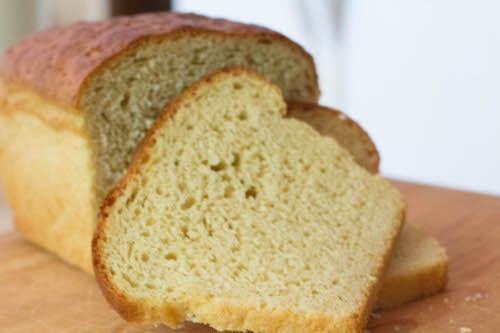
This loaf rose too much; was a bit chewy & dry, but still edible
Make Adjustments for Baking in a Hot Kitchen
The second time I attempted this bread, I made several adjustments based on the issues I found with the first loaf. I ended up using more water than the original formula, but not as much as I did for the first loaf. I also reduced the yeast by half and increased the salt to help keep the dough from rising too fast and too much in the heat. I kept the flour ratio and the amount of honey the same for both loaves.
Einkorn is very extensible so the dough came together really easily. However, the gluten structure is weaker so it doesn’t benefit from a long mix like you would with regular bread flour.
This time, I paid careful attention to the bulk fermentation period and the final proof so the loaf didn’t overproof. As a result, this loaf turned out much better. It rose beautifully, but not too much. The extra salt helped with the texture and the flavor. The texture was soft and fluffy like sandwich bread is supposed to be and the flavor was good.
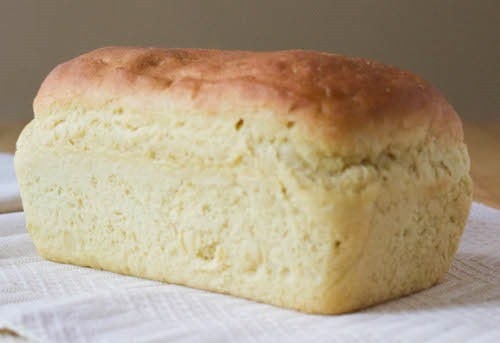
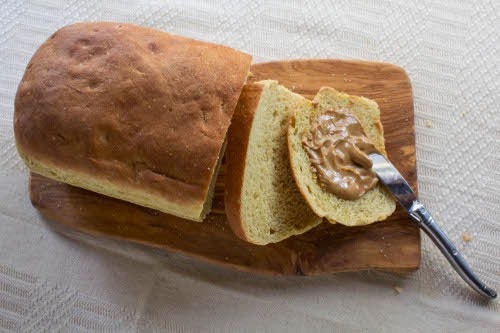
I enjoyed slices of this bread with butter and peanut butter, two of my favorite taste tests for sandwich loaves. The loaf passed both tests.
Adapted from: Classic Einkorn Sandwich Loaf by Jovial Foods
Print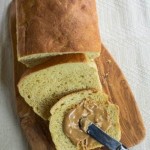
Baking Einkorn Sandwich Loaf in a Hot Kitchen
- Yield: 1 loaf 1x
Ingredients
- 4 cups (480 grams) all-purpose einkorn flour
- 1 teaspoon (3.5 grams) instant yeast
- 1 1/2 teaspoons (8.5 grams) sea salt
- 1 1/8 cups (260 grams) water, lukewarm
- 1 tablespoon (14 grams) honey
Instructions
Whisk together the flour, salt, and yeast in a large mixing bowl.
Mix the warm water and honey in a separate container and stir to dissolve.
Add the water/honey mixture to the flour mixture and mix, using your hands or a Danish dough whisk, until there are no dry bits of flour. Add in additional water if necessary.
Transfer the dough to a lightly floured work surface and knead gently until smooth.
Place the dough in a large, clean mixing bowl and let it rise at room temperature for 45 minutes to an hour.
When the dough has doubled in bulk, remove it from the bowl to a lightly floured work surface and shape into a loaf.
To shape the loaf, press the dough out into a rough rectangle, then fold the bottom and top edges in like a letter, pressing the seams closed so they don’t pop open during the proof cycle. Fold the left and right edges in toward the center; then fold it up again so the seam is enclosed in the center of the dough. Flip the loaf over and roll it gently back and forth on the work surface to elongate it to fit the loaf pan. Use a bench scraper to keep the dough from sticking to the work surface.
Place the loaf in a greased 8” x 4” loaf pan and cover with plastic. Let the loaf rise at room temperature for 30 minutes or until the loaf crests slightly over the top of the pan.
Bake the loaf for 35-40 minutes in a preheated oven at 350 degrees F. for nonstick pans and 325 degrees F. for glass loaf pans.
Remove the loaf from the oven, and if using glass pans, allow the loaf to rest in the pan for 10 minutes. Then remove the loaf to a wire rack to cool completely before slicing and serving.
Notes
I have not tested this particular recipe in milder weather yet, but this is the version that worked for me in my hot kitchen during the summer.
- Category: Sandwich Bread
- Method: Yeast
Happy Baking!
Cathy
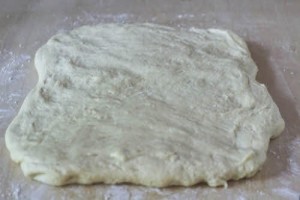
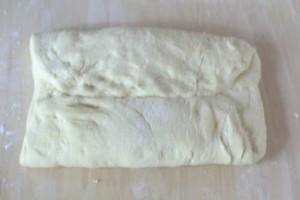
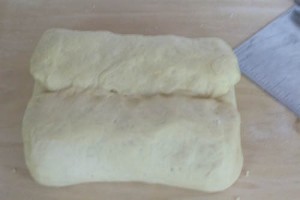
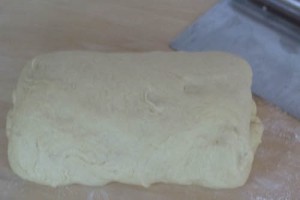
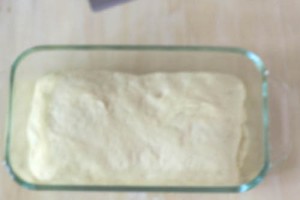
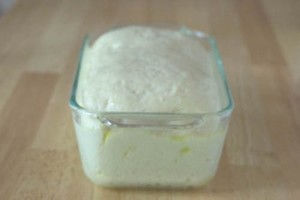
mdelp says
Where do you get that kind of flour? I’ve never heard of it.
Cathy W. says
Hello, you can order it from JovialFoods.com.
Karen Kerr says
Looks great Cathy! You poor thing with that hot kitchen even with the air on!!
Cathy W. says
Thanks Karen! It’s not so bad. I’m just happy to be baking bread.
MyKitchenInHalfCups says
I do enjoy learning/working with new flours. This is one I’ve not tried. Your experimentation sounds terrific.
I know what you mean about enjoying baking bread, some days it’s like sunshine.
Laura says
could this work in a bread machine?
Cathy W. says
Hi Laura, I haven’t tried this recipe in a bread machine, but you can certainly give it a shot. You might want to reduce the yeast a little bit.
Anonymous says
Cathy, I have to tell you that this is THE BEST recipe using Einkorn flour for bread. Thank You for your experiments. Bigg Daddy
Cathy W. says
So glad you enjoyed it. Happy Baking!
Anonymous says
Cathy: I live in Mississippi so my kitchen has similar temperature. What do you think the kitchen temp as in Tuscany? I really appreciate your information.
Cathy W. says
Hello, I’m not sure what the temperature is in Tuscany right now, but when I was there in May, it was in the 70s. It was very nice.
Anonymous says
We purchase einkorn through Azure Standard.
Kathy says
Hi Cathy – I’m just wondering – have you experimented with this recipe in cooler weather yet? Thanks!
Cathy says
Hi Kathy, I have not experimented with this recipe in cooler weather. The main adjustment I would make, if any, would be to reduce the amount of water used. But the percentage of water-to-flour is already at 54% so you wouldn’t want to reduce it by too much.
Amy says
Have you tested this with the whole grain? IF so, did you make any adjustments. There are a lot of people that say adding a water roux (tangzhong) actually improves the lift and crumb of the bread, so it might be something to try. My problem is my technique; I never know when I have messed with the dough enough to get it all mixed together and kneaded, because I know the less I mess with einkorn dough the better it will be. Hopefully I can get mine to look as good as yours one day!
Cathy says
Hi Amy, I love the tangzhong method, but I have not tried it with this bread. However, I have made a whole grain einkorn sandwich loaf that utilizes an overnight sponge. The sponge provides flavor and helps support the loaf https://www.breadexperience.com/market-market-sandwich-loaf-many-flours/.
Jessie says
I love einkorn flour. I wanted to ask have you ever tried to do an einkorn sandwich loaf with sourdough starter? I’m looking to make one. So far I’ve tried some regular flour recipes without success. If you’ve tried this with starter, how much did you use?
Cathy says
Hello Jessie,
I have not tried a sourdough version of this bread. However, probably the easiest way to incorporate it using this particular recipe is to use 1 cup of starter and reduce the flour and water by 1/2 cup each, assuming you are using a 100% starter (meaning it is fed with an equal amount of flour and water).
You’ll need to extend the bulk fermentation – total should be about 3-5 hours. Sourdough requires a longer fermentation time, however, keep in mind that if the kitchen is warmer, it will rise faster. If it rises too much, it could be too dense once you bake it.
Happy Baking!
Cathy
Faye Kroese says
I have just purchased my first box of Einkorn flour from Young Living and am anxious to give this recipe a try. My daughter in law is gluten sensitive (she can have some) and loves bread so I am hoping to find a good recipe!
Cathy says
Hi Faye,
I do hope your daughter-in-law is able to tolerate einkorn. I know it must be hard for someone who loves bread. Is the box of flour you got from Young Living whole grain flour or all-purpose? This recipe utilizes all-purpose einkorn. You can certainly use whole grain flour, but you’ll probably need a little more hydration and the loaf will be denser than what is shown in the photo. Do let me know how it turns out.
Happy Baking!
Cathy
Derwyn Docken says
Hi Cathy;
What adjustment would I make if I used equal portions of einkorn all purpose and einkorn whole wheat?
Cathy says
Hi Derwyn,
You’ll probably need more hydration since whole grain typically soaks up more than all-purpose. Let me know how it goes.
Happy Baking!
Cathy
Deborah wilson says
I have this flour in my freezer been wanting to try it I’m looking forward to trying this thank you
Cathy says
Great! Let me know how it turns out.
Pat Bourret says
I noticed you did not using any oil or butter. Is there a reason why?
Cathy says
Hi Pat, this particular bread doesn’t utilize any enrichments, such as fats or dairy.